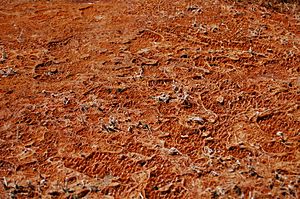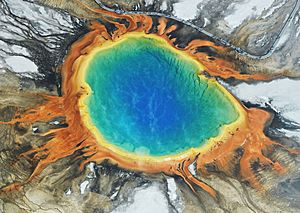Thermophile facts for kids
A thermophile is an organism—a type of extremophile—that thrives at relatively high temperatures, between 41 and 122 °C (106 and 252 °F). Many thermophiles are archaea, though some of them are bacteria and fungi. Thermophilic eubacteria are suggested to have been among the earliest bacteria.
Thermophiles are found in various geothermally heated regions of the Earth, such as hot springs like those in Yellowstone National Park (see image) and deep sea hydrothermal vents, as well as decaying plant matter, such as peat bogs and compost.
Thermophiles can survive at high temperatures, whereas other bacteria or archaea would be damaged and sometimes killed if exposed to the same temperatures.
The enzymes in thermophiles function at high temperatures. Some of these enzymes are used in molecular biology, for example the Taq polymerase used in PCR. "Thermophile" is derived from the Greek: θερμότητα (thermotita), meaning heat, and Greek: φίλια (philia), love.
Classification
Thermophiles can be classified in various ways. One classification sorts these organisms according to their optimal growth temperatures:
- Simple thermophiles: 50–64 °C (122-147.2 °F)
- Extreme thermophiles 65–79 °C (149-174.2 °F)
- Hyperthermophiles 80 °C and beyond, but not < 50 °C. (176+ °F)
In a related classification, thermophiles are sorted as follows:
- Facultative thermophiles (also called moderate thermophiles) can thrive at high temperatures, but also at lower temperatures (below 50 °C (122 °F)), whereas
- Obligate thermophiles (also called extreme thermophiles) require such high temperatures for growth.
- Hyperthermophiles are particularly extreme thermophiles for which the optimal temperatures are above 80 °C (176 °F).

Many of the hyperthermophilic Archaea require elemental sulfur for growth. Some are anaerobes that use the sulfur instead of oxygen as an electron acceptor during cellular respiration (anaerobic). Some are lithotrophs that oxidize sulphur to create sulfuric acid as an energy source, thus requiring the microorganism to be adapted to very low pH (i.e., it is an acidophile as well as thermophile). These organisms are inhabitants of hot, sulfur-rich environments usually associated with volcanism, such as hot springs, geysers, and fumaroles. In these places, especially in Yellowstone National Park, zonation of microorganisms according to their temperature optima occurs. These organisms are often colored, due to the presence of photosynthetic pigments.
Fungal thermophiles
Fungi are the only group of organisms in the Eukarya kingdom that can survive at temperature ranges of 50–60 °C. Thermophilic fungi have great biotechnological potential due to their ability to produce industrial-relevant thermostable enzymes, in particular for the degradation of plant biomass.
See also
 In Spanish: Termófilo para niños
In Spanish: Termófilo para niños


